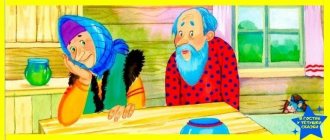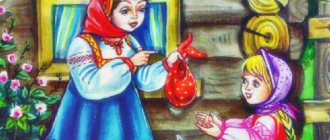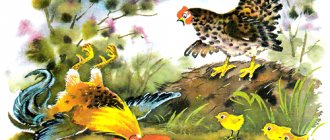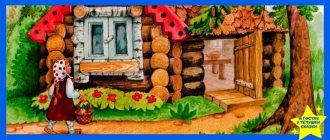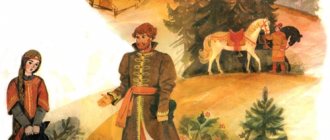Abstract of the NOD “Russian folk tale “Kolobok””
Summary of direct educational activities for the implementation of the educational field “Speech development” (speech development) in a mixed-age group.
"Russian folk tale "Kolobok""
Kazarinova-Dokuchaeva Ekaterina Dmitrievna
Tasks:
Educational:
Expand children's understanding of the topic "Fairy Tale".
Developmental
:
Develop variable thinking, speech, memory, attention, imagination, ability to analyze.
Develop the ability to play a role.
Develop the skill of noticing inconsistencies in the conveyance of the content of the text when listening to the story of comrades.
Educational:
Foster a sense of respect for the artist.
Speech:
Coherent speech: learn to answer the teacher’s questions with a complete answer, making grammatically correct sentences; develop prediction skills.
Dictionary: subject - fairy tale, heroes, viewer, character; qualitative –
cunning, big gray, eared; verbal – tell, speak, listen..
Grammar: continue to teach children to form new words for plural nouns.
Sound culture of speech: develop children's auditory concentration.
Individual work:
Encourage the use in speech of compound and complex sentences and elementary methods of word formation.
Methods and techniques:
Practical: a surprise moment - pay attention to the illustrations, theatrical activities.
Visual: illustrations for fairy tales, hero masks.
Verbal: conversation, theatrical activity.
Materials:
illustrations, audio recording, hero masks, screen
Progress of the lesson
The teacher draws the children's attention to the illustrations for the fairy tale. Children sit in a semicircle.
Educator:
guys, look who is shown in the pictures? What fairy tale are these characters from? Is this an author's fairy tale or a Russian folk tale?
Children's answers (kolobok, grandfather and woman, bunny, wolf, bear, fox; kolobok; Russian folk)
Educator:
right. Well done. You are very observant. I want to remember this fairy tale with you.
The teacher begins to tell a fairy tale. The children take turns continuing the story.
Educator:
Well done. We remembered the whole fairy tale. I have a surprise for you.
The teacher demonstrates masks-heroes of the fairy tale.
Educator:
These are masks. With their help, you and I will turn into fairy tale heroes and show the children a performance.
The teacher selects children from 4 to 6 years old. They will perform. The rest of the children will be spectators. Children choose their own mask. All the heroes go behind the screen.
Educator:
our artists behind the screen. The artists will perform on stage. You are the audience. I will be the narrator and sound engineer. Begin.
Children-heroes show the fairy tale, the rest of the children play the role of spectators, the teacher is the narrator and sound engineer.
Educator:
Oh. What a wonderful fairy tale it turned out to be. Let us thank the artists with applause.
Children clap their hands. The performers behind the scenes take off their masks and sit on the carpet.
Educator:
Who was your favorite character? What was the most interesting thing?
Children's answers (the fox is beautiful and cunning. The wolf growled loudly. The bear stomped angrily).
Educator:
Well done boys! I suggest you take pencils and coloring books.
Next is the independent activity of children - visual activity.
Target.Introduce the fairy tale “Kolobok” (design by K. Ushinsky). Exercise children in forming words by analogy.
Progress of the lesson
Part I
Many children read the fairy tale at home, and many watched a cartoon based on the fairy tale. Therefore, at the beginning of the lesson, the teacher finds out from them who the bun is. He listens to the answers and reads out an excerpt, summarizing the children’s statements: “I kneaded the dough with sour cream, rolled it into a bun (the children show how to roll a bun), fried it in oil.”
The teacher reads the fairy tale so that the children rejoice when the bun safely escapes from the animals, and are upset when they realize that the fox will outwit him.
The teacher gives the children time to exchange impressions. He clarifies what the hare, wolf and bear said to the bun when they met him. (“Kolobok, Kolobok! I’ll eat you!”)
“What did the sly fox say when he saw the bun? - the teacher is interested. - “Hello, bun!” How handsome and rosy you are!” – the fox praised the bun, he was delighted, but did not feel the fox’s cunning. His journey ended sadly. How did it end? (“And his fox – am!”
–
and ate it!”)
The teacher briefly talks about how carefully the children looked at the drawings for the fairy tale “Kolobok”.
“Ole,” says the teacher, “liked the drawing by Yu. Vasnetsov (it is advisable to name the artist). Olya described it this way... (the child’s answer is heard and supplemented if necessary).
Andryusha liked the drawing by A. Eliseev (shows). Tell about him.
And almost all the children liked this drawing. (Shows him.) Why? (Children's statements.)
I am glad that you are not just leafing through books, but also looking at the drawings. In your favorite drawing, I also noticed... (describes the illustration).
“I will leave these books in the group,” the teacher concludes the lesson, “and if you notice something interesting in the picture(s), be sure to show me.”
Part II.
“Let's play with words,” the teacher suggests.
– I will name words denoting large objects, and you will pronounce words denoting smaller or very small objects. For example, a house is a house, a pot is a pot, a book is a little book...”
Example words: scoop, bucket, ribbon, flower, button, dress, wheel, branch, bush, etc.
Concluding the lesson, the teacher informs the children that many famous artists made drawings for the fairy tale “Kolobok” (Yu. Vasnetsov, E. Rachev, A. Savchenko, L. Tokmakov, V. Gildyaev, A. Eliseev, etc.). Shows the children books about koloboks, asks them to look at them carefully, show them the drawing they liked the most and tell them why.
Notes on speech development in the second junior group “Reading the fairy tale “Kolobok”
Tatiana Chertygasheva
Notes on speech development in the second junior group “Reading the fairy tale “Kolobok”
Goal: to introduce children to the Russian folk tale “ Kolobok ”
, introduction to oral folk art, continue to teach children to carefully examine illustrations in books.
-development of coherent speech and enrichment of children’s vocabulary;
-development of attention and memory of children;
-education for Russian folk tales ;
-development of the ability to describe what is seen.
Equipment and materials: books with the fairy tale “ Kolobok ”
different artists, toy
bun .
-verbal: reading fairy tales , children's stories , conversation;
-visual: looking at illustrations.
Progress of the lesson:
-Guys, I want to tell you a riddle, and you try to guess it.
Round side, ruddy side
Who is this? ( Kolobok )
.
Look, he came to visit us (a fake kolobok )
.
Guys, what shape is Kolobok ? (Round)
- Come on, you and I will find more round-shaped objects on the table
Didactic game “Round shape”
Objects of different shapes are laid out on the table. Children should choose those that are round in shape.
- Well done, what is the name of the fairy tale where the main character is Kolobok ? ( " Kolobok "
).
-Yes. This is a Russian folk tale , which is called “ Kolobok ”
.
If you want, guys, I’ll tell you and show you this fairy tale , and you’ll help me.
The teacher organizes a tabletop fairy tale , the children help name the order in which the characters appear, pronounce the words in the song Kolobok .
- Well done guys, remember the fairy tale . Now let’s warm up a little and do some physical education.
The bear has a big house (raise your arms up, rise on your toes,
And the hare has a small one (crouching, extend your arms in front of you,
Our bear went home (step from foot to foot,
And behind him comes the bunny (jumping)
.
We are seeing off the animals (we wave our hand)
And we continue the lesson .
Didactic game “Who is missing”
The teacher leaves all the fairy tale and draws the children’s attention to which characters stand where. He invites you to close your eyes, removes one of the heroes, the children open their eyes and guess who is hiding.
- Well done guys, you did it. But the grandparents were very upset that the fox ate Kolobok . Let's make them new Koloboks from plasticine .
In order for the hands to sculpt well, we need to do gymnastics for the fingers.
We made the dough ourselves
Like this, like this (we show how to knead the dough)
We baked the bun ourselves
Like this, like this (we show how to make a Kolobok )
— Guys, what color of plasticine should you take to make Kolobok ? (yellow)
.
- Right, why? (because it was roasted in the oven)
- Now watch how I will sculpt Kolobok .
First, let's knead our plasticine so that it becomes soft. Now you can sculpt Kolobok . Place it on your palm, hold it with your other palm and roll it out in a circular motion.
After the show, the children make a Kolobok , rolling out a lump of plasticine in their palms in a circular motion.
- Well done guys, how hard you tried! Koloboks the grandparents now have . Now they definitely won’t be sad and say “Thank you!”
And our
lesson has come to an end .
Summary of a lesson on reading fiction on the topic “Russian folk tale “The Snow Maiden”” Integration of educational areas: Cognitive, speech, artistic and aesthetic development Goal: Awareness of one’s emotional.
Summary of a lesson on reading fiction in the senior group based on the story by N. Nosov “The Living Hat” Summary of a lesson on reading fiction in the senior group based on the story by N. Nosov “The Living Hat”. Goal: mastering the basics.
Summary of OOD on reading fiction “Learning the poem by O. Chusovitina “The Best” Topic: Reading fiction Learning the poem by O. Chusovitina “The Best” Goal: creating a social situation of development.
Summary of a lesson on reading fiction “Space” Purpose: to expand children’s understanding of space and the planets of the solar system. Objectives: Educational: develop the ability to perceive text:.
Summary of the final NOOD on reading fiction and applications in the senior group “Journey through the world of literature” Purpose: Systematize knowledge about different genres of literature: fairy tales, poems, stories. Cultivate a love for Russian folklore. OO objectives.
Abstract of the educational activity on reading fiction “Visiting Grandmother Varvara” in the second junior group. Abstract of the educational activity “Reading fiction” in the second junior group on the topic “Visiting Grandmother Varvara” Program objectives: Educational.
Summary of a lesson on reading fiction for children of the preparatory group Summary of reading fiction for children of the preparatory group “How difficult it is to be good” using productive technology.
Summary of a lesson on speech development and reading fiction. Russian folk tale “Masha and the Bear” Summary of a lesson on speech development and reading fiction. Russian folk tale "Masha and the Bear". Goal: Creation of social.
Source
Progress of the lesson:
Educator. What do you think is in it? (children's answers)
Educator. Let's get a look. Guys, this is a fairy tale . Let's think about who this fairy tale ? Right. It's about the kolobok . And the bun invites us to read it. Well, let's read a fairy tale about a kolobok ?
Educator. Then listen (reads a fairy tale about a bun )
.
Educator. How do you guys like the fairy tale ? Did you like it? (children's answers)
Educator. What was the kolobok ?
Educator. And who cooked it up?
Educator. Where did grandma put it when she baked it?
Educator. Where did he go?
Educator. Whom did you meet on your way? (children's answers)
Educator. What did the hare, wolf and bear tell him? (children's answers)
Educator. What did the fox say ? (children's answers)
Educator. How did his journey end? (children's answers)
Educator. Right. We are making him many new friends, just like him. But before we get to work, let's play a little with our kolobok and cheer him up.
We came to visit a fairy tale
Found a chest with a lock
And they sat down and stood up,
And they jumped like a bunny.
Let's stretch our hands,
Educator. Well done. Now let's get to work (children together with the teacher make koloboks )
.
Educator. Well done boys. These are the beautiful koloboks we made . Now our bun will not be bored . How many friends does he have (exhibition of works)
.
Photo report on the dramatization of the Russian folk tale “Kolobok” “The theater is a magical world.
He gives lessons in beauty, morality and ethics. And the richer they are, the more successful the development of the spiritual world is. Photo report on the game-dramatization of the Russian folk tale "Kolobok" Photo report on the game dramatization of the Russian folk tale "Kolobok" To begin with, we decided to refresh our memory of the text of the fairy tale. Kids pay attention. Photo report on the staging of the Russian folk tale “Kolobok” with children 2–4 years old h3] Purpose: to teach to imitate the voices of animals. Strengthen your knowledge of Russian folk tales. Practice pronouncing individual phrases. Bring up. Summary of educational activities on speech development for children of primary preschool age. Reading the Russian folk tale “Rukavichka” Tsviklo Irina Vasilyevna, teacher of the Nazyvaevsky Kindergarten No. 1, Nazyvaevsk, Omsk Region Abstract of directly educational. Abstract of the GCD in the junior group “Reading the Russian folk tale “The Wolf and the Seven Little Goats”” Speech development. Fiction. Topic: Reading the Russian folk tale “The Wolf and the Seven Little Goats.” Goal: Acquaintance with Russian folk.
Summary of educational activities for speech development in the middle group. Reading the Russian folk tale “The Cockerel and the Bean Seed” Summary of GCD in the middle group for speech development. Reading the Russian folk tale “The Cockerel and the Bean Seed.” Integrated lesson p.
Source
